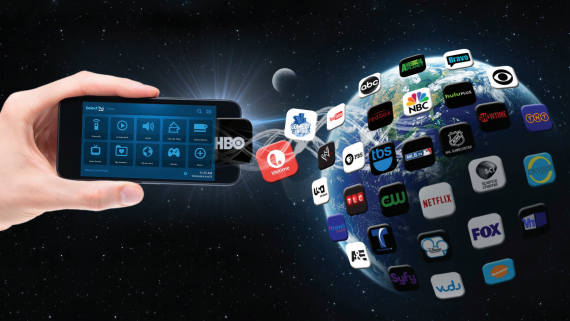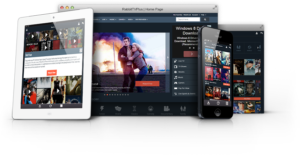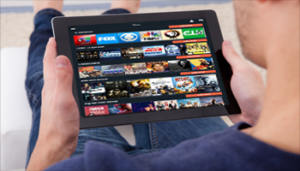Connections

M&E Journal: TV Networks’ Rush to the Web May Be Fruitless Without Aggregation
Story Highlights
By Bill Mobley, CEO, FreeCast –
The consumer migration from cable and satellite TV to web-based video providers continues, with no sign of slowing down. Now more than ever, the pressure is on for media and tech companies to get a slice of the rapidly growing web TV pie. But as multi-billion-dollar media giants fight to stay in consumers’ rapidly-changing living rooms, a brand-agnostic aggregator is a better bet to successfully build out the technologies that will keep them in front of consumers’ eyeballs.
2015 was marked by the emergence of a plethora of new SVOD libraries, led by Time Warner’s HBO Now service. In 2016, virtual pay-TV offerings of so called “skinny bundles” captured attention as big players announced plans to join Sling TV in the space. Some analysts are now predicting another shift, this time toward aggregators. And already, some of Silicon Valley’s biggest companies are getting on board, turning to aggregation.
Too much of a good thing
The secret, as any cord-cutter will tell you, is this: nearly everything you see on cable TV can already be found online. Much of it is free, but even premium content is generally much cheaper on the web versus through satellite and cable providers.
As new services aimed at cord-cutters come online, from skinny bundles to apps from specific TV networks and niche content providers, they’re seldom bringing new content to web-watchers, but rather, new ways to access the same content that consumers have enjoyed all along.
The growing number of content sources reflects the growing number of companies jockeying for a piece of consumers’ TV budgets. But from the consumer perspective, all this content is now being siloed in an increasing number of standalone apps and services.
Cord-cutters rejoice as each new streaming service enters the marketplace, but that celebration is short-lived. Those same cord-cutters are fed up with having to sign in to a dozen different apps and websites just to save a few bucks, while cable subscribers can surf their entire channel lineup with a single button.
Everybody loses as a result: even services with popular content, like the oft-requested HBO Now and over-the-top ESPN offering via Sling TV, are struggling to gain traction.
 Consolidation coming
Consolidation coming
Consumers abandoning cable TV are doing so to abandon their skyrocketing cable bills, not the content that they watch. So, when the content that could once be accessed from two or three subscription VOD services splinters into a dozen, each one around $10 per month, that consumer is right back to paying upwards of $100 a month for TV, and the whole thing falls apart.
The problem is simple and familiar, because it’s the same one cable customers have faced for years: There’s somebody who wants to see every show and movie out there, but nobody wants to see (or more importantly, be stuck paying for) all of it.
So, while these TV network streaming services languish, consumers are still on the sidelines waiting for something that will give them what they’ve been asking for all along: an easy way to get just the content they want, no more and no less. Now that there are multiple options for getting most content, they need to be able to understand their options and make the best choices.
For the ailing TV industry to turn the corner, it needs to start serving consumers’ needs, and not just corporate bottom lines. Make customers happy, and profits will follow. But trying to coax consumers into spending more than they want to has had the opposite effect: subscribers are fleeing to the tune of millions.
Innovating access
While TV networks and movie studios that already have vaults of content may find an easy option is to simply throw it all online in the form of an SVOD library, the tech giants have opted for a different approach: aggregation.
Apple, having explored both SVOD and virtual pay-TV, famously abandoned both of those plans in favor of offering a guide to existing streaming content. Amazon too, in addition to a vast pay-per-view and subscription library, has begun including other subscription services on its site. Google and Microsoft’s search engine, Bing, both bring up viewing options when users search for shows or movies.
But despite the investment that these massive companies are making in media aggregation, aggregation has a key advantage. It isn’t some exclusive content or deal, in fact, it’s the exact opposite: aggregators don’t sell content, making it easier to pull together content from rival sources.
For most companies, striking a deal with one TV network or movie studio makes it that much harder for them to talk to another. Likewise, no matter how much Apple invests in its own guide, it will never be more useful to consumers than an agnostic aggregator if the Apple service can’t point a consumer to Amazon or Google Play if a piece of content they want to watch is less expensive there. By the same token, Amazon’s not going to tell a Prime customer not to rent that movie because they can find it for free with their Netflix subscription.
 Aggregation’s advantages
Aggregation’s advantages
Each of these companies would rather sell you something more expensive from their own stock than let you know that it can be had cheaper from a competitor.
Yet that’s exactly what consumers want: one source that will easily tell them where to find what they want to watch at the best price. And that’s the key advantage that aggregation brings to consumers.
That benefit is lost when these big companies choose only to be helpful to consumers when it’s advantageous to them.
Full circle
This problem that consumers and TV networks are both faced with mirrors one from the early days of cable TV. That service’s evolution would not have been possible had cable systems, and later satellite providers, not been agnostic. If signing up for cable TV service meant you could only receive, as an example, NBC-owned or approved channels, while CBS, FOX, and ABC were barred, nobody would have bothered.
Instead, a dozen channels became 50, and the original TV Guide took up residence in many living rooms, right beside the remote. Consumers loved having more to watch, but it was starting to become too much to keep track of without help.
Soon even standard cable lineups would include hundreds of channels, joined by on-demand and pay-per-view content galore, while the print TV Guide was replaced by a digital, on-screen version. Today, if you were to take that guide away, those hundreds of channels and on-demand options would become all but unnavigable.
Yet that’s exactly the situation that exists for web-based entertainment!
There is a thousand times more content available online than with any cable or satellite subscription, coming from thousands of different sources. It would be a no-brainer to replace costly cable TV, but the online experience suffers from the lack of that key element: a guide.
That’s the difference maker. Cord-cutting began as something attempted only by the most tech-savvy or frugal. Now, it’s becoming more mainstream, and there’s even a generation of “cord-nevers” upon us. That guide to the otherwise wild world of online video will be what makes it possible for all.
—
Click here to translate this article
Click here to download the complete .PDF version of this article
Click here to download the entire Spring 2017 M&E Journal









